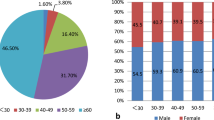Abstract
Monoclonal gammopathies are characterized by the presence of monoclonal immunoglobulin in patients with or without evidence of multiple myeloma (MM), macroglobulinemia, amyloidosis (AL), or a related plasma cell proliferative disorder. This study aims to evaluate laboratory diagnostic characters of monoclonal gammopathies and investigates the correlation between monoclonal gammopathies and transforming growth factor β1 (TGFβ1). Immunofixation electrophoresis (IFE), serum protein electrophoresis (SPE), nephelometry and urine light chain ELISA were used for laboratory identification of monoclonal immunoglobulins. Plasma TGFβ1 was detected with double-antibodies ELISA. Lightcycler was used for single nucleotide polymorphism (SNP) analysis. Totally 2,007 cases of monoclonal immunoglobulin (M protein) were identified in 10,682 samples. The isotypes of M protein were IgG type 47.1%, IgA 23.0%, IgM 8.7%, IgD 5.3%, free light chain κ 6.1%, λ 9.8%. In reference to IFE, the coherency of diagnosis was serum light chain ratio (κ/λ) 94.4%, quantitation of Igs 83%, light chain quantitation 80.9%, and urine light chain ratio (κ/λ) 58.0%. Plasma TGFβ1 was elevated significantly compared to normal control. The allelic frequency of codon 10 (C > T) was neither associated with the existence of the M protein nor with the M protein isotype. Monoclonal gammopathies can be identified with the combination of IFE, SPE, Igs quantitaion and urine light chain determination. Although TGFβ1, an important cytokine in immune regulation, was elevated in monoclonal gammopathies, the SNPs in coding region of TGFβ1 gene did not confer susceptibility to the development of monoclonal gammopathies in this study.
This is a preview of subscription content, access via your institution
Access options
Subscribe to this journal
Receive 12 digital issues and online access to articles
$119.00 per year
only $9.92 per issue
Buy this article
- Purchase on Springer Link
- Instant access to full article PDF
Prices may be subject to local taxes which are calculated during checkout
Similar content being viewed by others
Author information
Authors and Affiliations
Corresponding author
Rights and permissions
About this article
Cite this article
Wang, H., Gao, C., Xu, L. et al. Laboratory Characterizations on 2007 Cases of Monoclonal Gammopathies in East China. Cell Mol Immunol 5, 293–298 (2008). https://doi.org/10.1038/cmi.2008.36
Received:
Accepted:
Issue Date:
DOI: https://doi.org/10.1038/cmi.2008.36
Keywords
This article is cited by
-
Immunoglobulin heavy/light chain ratios improve paraprotein detection and monitoring, identify residual disease and correlate with survival in multiple myeloma patients
Leukemia (2013)
-
AL amyloidosis with IgD-lambda monoclonal gammopathy and lambda-type Bence-Jones protein: successful treatment by autologous stem cell transplantation
Clinical and Experimental Nephrology (2010)



